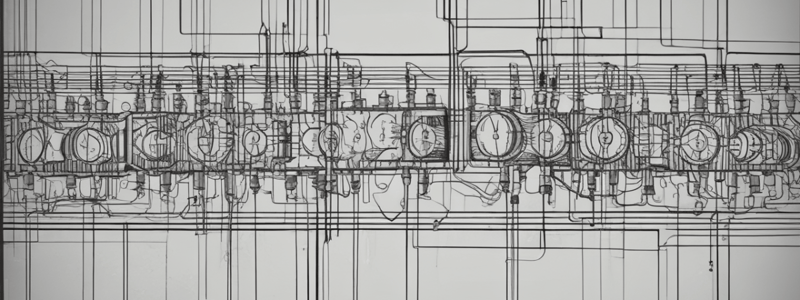Podcast
Questions and Answers
Which statement correctly describes Ohm's law?
Which statement correctly describes Ohm's law?
- Current is directly proportional to voltage and inversely proportional to resistance. (correct)
- Resistance is directly proportional to voltage.
- Current is inversely proportional to voltage.
- Voltage is equal to the product of current and resistance.
What happens to current when resistance increases while voltage remains constant?
What happens to current when resistance increases while voltage remains constant?
- Current increases.
- Current fluctuates randomly.
- Current decreases. (correct)
- Current remains the same.
In the context of an electrical circuit, what does voltage measure?
In the context of an electrical circuit, what does voltage measure?
- The resistance to the flow of charge.
- The potential difference between two points. (correct)
- The total charge in a circuit.
- The amount of current flowing per unit time.
If a resistor in a circuit has a resistance of 4 Ohms and the voltage supply is 12 V, what is the current?
If a resistor in a circuit has a resistance of 4 Ohms and the voltage supply is 12 V, what is the current?
How do collisions of molecules in a conductor affect electrical current?
How do collisions of molecules in a conductor affect electrical current?
Which of the following correctly states the relationship between voltage, current, and resistance in a circuit?
Which of the following correctly states the relationship between voltage, current, and resistance in a circuit?
Which law states that current is directly proportional to voltage and inversely proportional to resistance?
Which law states that current is directly proportional to voltage and inversely proportional to resistance?
If the voltage in a circuit is 10 volts and the resistance is 2 ohms, what is the current flowing through the circuit?
If the voltage in a circuit is 10 volts and the resistance is 2 ohms, what is the current flowing through the circuit?
What do we call materials that follow Ohm's Law and have constant resistance?
What do we call materials that follow Ohm's Law and have constant resistance?
Which of the following is an example of a non-ohmic device?
Which of the following is an example of a non-ohmic device?
How can you calculate resistance if voltage is known but current is not?
How can you calculate resistance if voltage is known but current is not?
In which scenario does Ohm's Law NOT apply?
In which scenario does Ohm's Law NOT apply?
Which equation would you use to find current when the voltage is 15 volts and resistance is 3 ohms?
Which equation would you use to find current when the voltage is 15 volts and resistance is 3 ohms?
What happens to current in a circuit when the resistance is increased while keeping voltage constant?
What happens to current in a circuit when the resistance is increased while keeping voltage constant?
What does an increase in pressure from the tap or valve in a water hose analogy represent in a circuit?
What does an increase in pressure from the tap or valve in a water hose analogy represent in a circuit?
In the analogy of a river, what role do sediments and pebbles play with respect to water flow?
In the analogy of a river, what role do sediments and pebbles play with respect to water flow?
If the amount of current in a circuit decreases, what is the expected effect on resistance?
If the amount of current in a circuit decreases, what is the expected effect on resistance?
In the context of the water-hose analogy, what does the term 'current' relate to?
In the context of the water-hose analogy, what does the term 'current' relate to?
What does the height difference in a river illustrate in electrical terms?
What does the height difference in a river illustrate in electrical terms?
How does increasing resistance affect the water flow in the hose?
How does increasing resistance affect the water flow in the hose?
Flashcards are hidden until you start studying
Study Notes
Voltage, Current, Resistance Overview
- The flow of water in a hose resembles the flow of electric current in a circuit.
- Increased pressure from a tap corresponds to increased voltage; constrictions in a hose relate to resistance.
- Water flow in a river represents current, while height differences depict voltage.
Ohm's Law
- Ohm's Law states the current (I) is directly proportional to voltage (V) and inversely proportional to resistance (R).
- Ohm's formula: I = V / R, showing the relationship among these three variables.
- A graph plotting voltage against current yields a straight line, indicating their direct relationship.
Current
- Current is the flow of electric charge in a circuit, measured in amperes (A).
- It can be affected by voltage and resistance, where higher resistance results in lower current.
Voltage
- Voltage, measured in volts (V), is the potential difference between two points in a circuit.
- It drives the flow of current; a battery is a common source maintaining voltage.
Resistance
- Resistance, measured in ohms (Ω), opposes current flow in a circuit.
- Factors such as wire length and material type affect resistance; longer or insulative materials increase resistance.
Relationships
- Higher voltage leads to increased current; increased resistance reduces current.
- For constant voltage, if resistance increases, current decreases. For example, at 3 V:
- Resistance of 1 Ω yields 3 A (I = V/R).
- Resistance of 2 Ω yields 1.5 A.
Measuring Instruments
- Ammeters measure current in a circuit connected in series.
- Voltmeters measure voltage across a component connected in parallel.
Types of Materials
- Ohmic materials (e.g., metals, resistors) have constant resistance and follow Ohm's law.
- Non-ohmic materials (e.g., diodes, semiconductors) do not follow Ohm's law, as their resistance varies with voltage and current.
Summary of Formulas
- For unknown voltage: V = I × R
- For unknown resistance: R = V / I
- For unknown current: I = V / R
Key Points
- Understanding the intricate relationships of voltage, current, and resistance is fundamental to mastering basic electrical circuits.
- The visual representation of these relationships aids in comprehending their interactions and effects in practical applications.
Studying That Suits You
Use AI to generate personalized quizzes and flashcards to suit your learning preferences.




